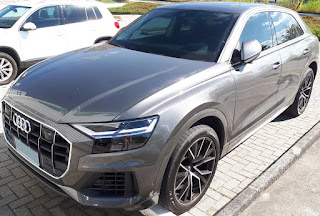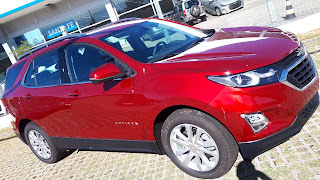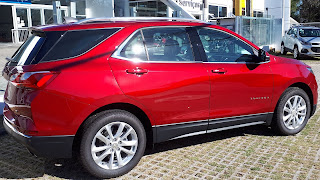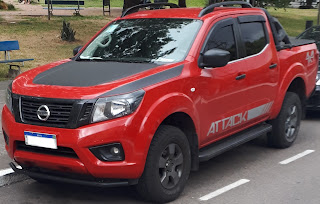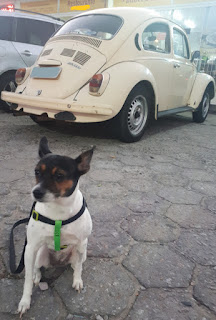It's impossible to deny the Cummins ISF2.8 is quite a crude engine, as it caters mostly to commercial utility vehicles for which cost-cutting measures are given a higher priority than utmost sophistication. Due to its marketing approach more focused on the so-called "emerging" markets, being fitted to light trucks such as some versions of the Volkswagen Delivery trucks range, at a first glance it might seem quite pointless to compare it to something way more complex within a somehow closer displacement range, but once we look at a simpler engine with a different perspective it may highlight a handful of features which would otherwise remain overlooked. Even though some lower states of tune usually applied for the sake of improving reliability may render it easier to underestimate an engine like this, there are some reasons to consider the viability of some higher-output approach to render it suitable to fancier vehicles.
Considering their displacements as not too far to the point of rendering a direct comparison unfair, the Cummins ISF2.8 may look inherently disadvantaged towards Volkswagen's own 3.0L variants of the V6 TDI which is fitted to the Audi Q8 among other models. While the 4-cylinder Cummins resorts to iron block and head, a wastegated turbocharger and a chain-driven single overhead camshaft (SOHC) valvetrain, the TDI gets a pair of aluminium cylinder heads with double overhead camshafts (DOHC) accounting to a total of 4 camshafts and an electronically-controlled variable-geometry turbocharger. Besides the inherent weight penalty of an iron cylinder head, the smaller amount of camshafts already provides a decrease on inertia and internal frictions which could be already beneficial, and since both engines feature 4 valves per cylinder it would be pointless to point at the ISF2.8 as disadvantaged to what the intake and exhaust flows might concern. When it comes to bore and stroke, which are often pointed out as extremely relevant to how rev-happy an engine may become, the Cummins with 94mm bore and 100mm stroke for a 0.94:1 R/L (radius/lenght) ratio could seem not so unsuitable to operate at higher RPM bands because it's less oversquare than the TDI which 83mm bore and 91.4mm stroke lead to a 0.91:1 R/L ratio. Undersquare engines have a bore smaller than the stroke, square ones have identical bore and stroke, while an oversquare features a bigger bore, usually leading to an ascending order of how rev-happy an engine might be even though it's not unarguable.
Sure the turbocharger also plays an important role when it comes to the aptitude of an engine to reach a broader RPM band with the fixed-geometry one fitted to the ISF2.8 requiring a smaller size in order to avoid a turbo-lag even though it leads to some flow restriction at higher engine speeds. Meanwhile, the variable-geometry turbocharger fitted to the 3.0 V6 TDI has adjustable blades on the exhaust side leading to a quicker low-end response and setting peak power and torque to higher RPMs which may allow the engine to proportionately increase its performance. Even though the Cummins rated at 153 hp at 3200 RPM and 430 Nm between 1500 and 2400 RPM may not seem so attractive compared to a TDI with 228 hp at 3250 RPM and 500 Nm from 1750 to 3250 RPM, it's still worth to look at some eventual advantages from the 4-cylinder layout which could be conciliated to a different turbocharger configuration in order to remain competitive against a high-end V6 within a similar displacement class.
Wednesday, June 17, 2020
Monday, June 15, 2020
5 vehicles which would be tempting to swap a Toyota 1FS industrial engine into
A somewhat unrefined engine, featuring a gear-driven OHV valvetrain and with its peak power and torque RPMs being somewhat low for modern automobile standards, the 3.7L Toyota 1FS engine is more easily found on forklift trucks and other special equipments. However, many factors could turn into a reasonable motivation to fit such a crude and seemingly unsuitable engine to a modern vehicle. At least 5 examples could be highlighted as tempting to swap the 1FS into:
1 - Chevrolet Colorado (current generation, renamed S10 in selected markets): for those who aren't into Diesel engines, the 1FS doesn't seem to mismatch a more utilitarian approach. The absence of a timing chain makes it a good alternative to the Ecotec 2.5 SIDI while the port-injection is easier to implement a gaseous fuel conversion than the direct injection fitted to the Ecotec which is harder to convert to run on CNG retaining the capability to operate on regular gasoline;
2 - Chevrolet Equinox: besides the direct injection and chain-driven DOHC valvetrain, the Ecotec 1.5L and 2.0L engines fitted to the current generation of the Equinox are also turbocharged. OK, the 1FS might seem excessively large for the low specific power and torque, and its overall narrow RPM band may seem at a first glance to not be so suitable for a decent overall performance not even when it's compared to the smaller engine, and the lack of some altitude compensation provided by the turbo is going to charge its toll on some routes. However, both the lower amount of failure-prone parts and its low-revving configuration make it tempting for an engine swap in countries where a displacement increase wouldn't make it subjected to higher licensing fees;
3 - Ford Ranger (current generation): even though the Diesel engines are highlighted on most markets, the gasoline-powered 2.5L Duratec is still available in some countries and is actually the only engine officially available for the Ranger in Bolivia. Once again, the ruggedness of the 1FS and the higher peak torque from a lower RPM make it quite tempting for a work truck as a replacement to the Duratec;
4 - Toyota Land Cruiser Prado J150: considering the reputation of the Land Cruiser range among the most reliable off-roaders, the ruggedness of the 1FS could be justified while comparing it to the 2.7L 2TR-FE which is the basic engine offered in markets where gasoline-powered vehicles are still common on its class. Avoiding a timing chain and keeping a lower-revving nature enhance the dependability on harsh environments;
5 - Nissan Frontier/Navara D23: even though the turbodiesel and twin-turbo Diesel engines are the most highlighted ones, the 2.5L QR25DE has been carried over from the previous generation and remains available in some markets throughout Latin America, Africa and Middle East. Even though mismatching the engine manufacturer in a Japanese vehicle may be more usual on motorsports than in utility vehicles, it doesn't seem so outrageous.
1 - Chevrolet Colorado (current generation, renamed S10 in selected markets): for those who aren't into Diesel engines, the 1FS doesn't seem to mismatch a more utilitarian approach. The absence of a timing chain makes it a good alternative to the Ecotec 2.5 SIDI while the port-injection is easier to implement a gaseous fuel conversion than the direct injection fitted to the Ecotec which is harder to convert to run on CNG retaining the capability to operate on regular gasoline;
2 - Chevrolet Equinox: besides the direct injection and chain-driven DOHC valvetrain, the Ecotec 1.5L and 2.0L engines fitted to the current generation of the Equinox are also turbocharged. OK, the 1FS might seem excessively large for the low specific power and torque, and its overall narrow RPM band may seem at a first glance to not be so suitable for a decent overall performance not even when it's compared to the smaller engine, and the lack of some altitude compensation provided by the turbo is going to charge its toll on some routes. However, both the lower amount of failure-prone parts and its low-revving configuration make it tempting for an engine swap in countries where a displacement increase wouldn't make it subjected to higher licensing fees;
3 - Ford Ranger (current generation): even though the Diesel engines are highlighted on most markets, the gasoline-powered 2.5L Duratec is still available in some countries and is actually the only engine officially available for the Ranger in Bolivia. Once again, the ruggedness of the 1FS and the higher peak torque from a lower RPM make it quite tempting for a work truck as a replacement to the Duratec;
4 - Toyota Land Cruiser Prado J150: considering the reputation of the Land Cruiser range among the most reliable off-roaders, the ruggedness of the 1FS could be justified while comparing it to the 2.7L 2TR-FE which is the basic engine offered in markets where gasoline-powered vehicles are still common on its class. Avoiding a timing chain and keeping a lower-revving nature enhance the dependability on harsh environments;
5 - Nissan Frontier/Navara D23: even though the turbodiesel and twin-turbo Diesel engines are the most highlighted ones, the 2.5L QR25DE has been carried over from the previous generation and remains available in some markets throughout Latin America, Africa and Middle East. Even though mismatching the engine manufacturer in a Japanese vehicle may be more usual on motorsports than in utility vehicles, it doesn't seem so outrageous.
Saturday, June 13, 2020
5 engines which could be a good upgrade to a VW Beetle
One of the most iconic cars, the Volkswagen Sedan/Käfer/Beetle/Fusca is recognised among many features for its flat-four air-cooled engine. However, it's a suitable platform for engine swaps which are likely to improve its performance, fuel-efficiency and provide auxiliary power for some comfort features with fewer stress than the old Boxer would. Among some engines which could be a good option, at least 5 can be highlighted:
1 - Renault K-Type engine: since it shares the bellhousing pattern with the old Cléon-Fonte and the "Energy" engines, and the Cléon-Fonte had some derivatives fitted to Volkswagen models in Brazil from the late-'80s to mid-'90s, a K-Type engine swap doesn't seem so much of a rocket science task;
2 - Volkswagen EA211: just like its predecessor EA111, the EA211 is a more compact alternative to the EA827 and its subsequent replacements. With the 3-cylinder 1.0L versions available either with natural aspiration and port-injection or turbocharging and direct injection, while the 4-cilinder takes the 1.2L to 1.6L range with the same availability of either natural aspiration and port-injection or turbocharging and direct injection, there are plenty of options from a more frugal to some spirited power and torque figures;
3 - GM Family 1/Family 0/Small Gasoline Engine: tracing from the use of Chevrolet 153 engines for swaps into Volkswagens in South Africa to the present-day downsizing trend which renders some turbocharged variant of the smaller engines available on newer Chevrolet cars and crossover SUVs suitable to perform basically the same duties the old 153 would perform, it wouldn't really surprise me to see some random Chevrolet engine ranging from 1.0L to 1.8L also either naturally-aspirated or turbocharged being considered as a suitable option to swap into a Beetle;
4 - Toyota TR engines: tracing from the usage of the Y engines for repowerings into Kombis in South Africa and some Asian markets, with the TR being its replacement for some applications, it's no surprise the 2.0L 1TR-FE would be an interesting option for performance and long-term reliability while the 2.7L 2TR-FE could seem quite overkill yet tempting for a sleeper;
5 - Fiat FIRE engine: ranging from 0.8L to 1.4L and with turbocharged versions available within the largest displacement, it's also widely used with alternate fuels such as ethanol, Natural Gas and LPG. Requires an adaptor plate to be coupled to the original VW transaxle, but it's no rocket-science.
1 - Renault K-Type engine: since it shares the bellhousing pattern with the old Cléon-Fonte and the "Energy" engines, and the Cléon-Fonte had some derivatives fitted to Volkswagen models in Brazil from the late-'80s to mid-'90s, a K-Type engine swap doesn't seem so much of a rocket science task;
2 - Volkswagen EA211: just like its predecessor EA111, the EA211 is a more compact alternative to the EA827 and its subsequent replacements. With the 3-cylinder 1.0L versions available either with natural aspiration and port-injection or turbocharging and direct injection, while the 4-cilinder takes the 1.2L to 1.6L range with the same availability of either natural aspiration and port-injection or turbocharging and direct injection, there are plenty of options from a more frugal to some spirited power and torque figures;
3 - GM Family 1/Family 0/Small Gasoline Engine: tracing from the use of Chevrolet 153 engines for swaps into Volkswagens in South Africa to the present-day downsizing trend which renders some turbocharged variant of the smaller engines available on newer Chevrolet cars and crossover SUVs suitable to perform basically the same duties the old 153 would perform, it wouldn't really surprise me to see some random Chevrolet engine ranging from 1.0L to 1.8L also either naturally-aspirated or turbocharged being considered as a suitable option to swap into a Beetle;
4 - Toyota TR engines: tracing from the usage of the Y engines for repowerings into Kombis in South Africa and some Asian markets, with the TR being its replacement for some applications, it's no surprise the 2.0L 1TR-FE would be an interesting option for performance and long-term reliability while the 2.7L 2TR-FE could seem quite overkill yet tempting for a sleeper;
5 - Fiat FIRE engine: ranging from 0.8L to 1.4L and with turbocharged versions available within the largest displacement, it's also widely used with alternate fuels such as ethanol, Natural Gas and LPG. Requires an adaptor plate to be coupled to the original VW transaxle, but it's no rocket-science.
Subscribe to:
Posts (Atom)


